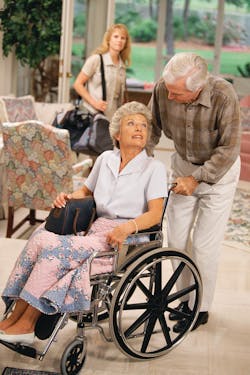Vertical Market Focus: Assisted Living & Health Monitoring--Emergency Response Systems and Personal Panic Buttons
Throughout the last few decades, the assisted living market has changed from one of simply providing clinical care, much like hospitals, to sprawling campuses which are often a blend of independent living, assisted living and skilled nursing services. These environments are becoming more popular among the growing elder population and for good reason. They allow residents a wealth of options regarding their own independence and a level of care based on their personal medical needs that may change over time.
In communities such as these, residents can have complete mobility within buildings as well as across acres of open, outdoor spaces. Assisted living campuses face unique challenges when it comes to providing residents and their families peace of mind that they can fully engage in events throughout the campus yet still have the ability to call for help should they need it, particularly in an urgent medical emergency. That’s where emergency response systems and personal panic buttons come into play.
Emergency response products are alerting systems designed to allow residents to send a call for help during a medical emergency anywhere on the assisted living campus. Typical systems consist of a personal panic button worn by the resident, a wireless network that carries the signal back to a receiver and a software head-end that both processes the alerts to initiate a timely response and supervises the health and functions of the system.
Wireless networks send immediate notification
Large assisted living campuses have embraced robust repeater-based networks as the backbone of the system, as they offer the most reliable solution when response time and lives are at stake. A wireless network that is capable of repeating an alarm from a personal panic button via multiple paths to the receiver at the head-end is ideal to ensure total reliability and guaranteed message delivery. For instance, if a repeater were not able to hear an alarm message due to interference, the message would propagate through the network through an alternative repeater path. In addition, the most reliable wireless networks offer constant supervision of the entire system.
Personal panic buttons should have the capability to not only transmit alarms, but also check in to the receiver at defined intervals to ensure real-time system status checks. This allows for early warnings to system administrators in the event of a potential problem, such as a personal panic button that has gone outside the range of the system's coverage area or one that has a low battery which needs replacement.
The most visible part of an emergency response system is the personal panic button, which is usually worn by the resident on the wrist, on a belt or around the neck. The personal panic button is one of the most important items a resident wears. While there may be other methods for a resident to call for help (such as wall-mounted pull cords or even the telephone), nothing can replace the freedom provided by a personal panic button that a resident can wear at all times—even in the shower or as they stroll about the campus. Because these devices become part of a resident’s everyday wardrobe, the form factor and ease of use are two of the most important considerations. Most residents prefer a small device that can be concealed if desired, but is large enough for them to access and press in the event of an emergency.
The balance between helping residents maintain their independence and providing peace of mind and protection can be a challenge for assisted living campuses. However, in a campus environment that promotes freedom and mobility to residents, it is clear that personal panic buttons and the wireless network and software head-ends that employ them provide the optimal solution.


